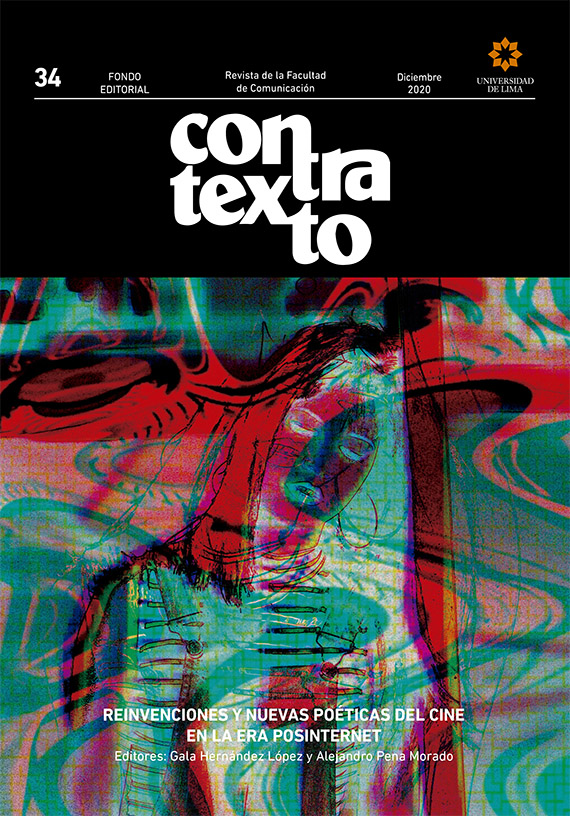El espectáculo, la cámara, la autoría y la vigilancia en el found footage
DOI:
https://doi.org/10.26439/contratexto2020.n034.4864Palabras clave:
Found footage, metraje encontrado, cámara de cine, ficción y no ficción, enunciado y enunciaciónResumen
Se discuten las características de las películas conocidas como found footage a través de la ontología de la cámara, la distinción entre ficción y no ficción, la distinción entre filmación y película, y entre un autor explícito y una agencia autoral de la enunciación. Para ello serán esenciales los aportes de Edward Branigan y Carl Plantinga. Se analizan películas a partir de estos ejes, donde se trata de entender el modo singular en que cada filme articula el problema universal del género: la brecha entre el enunciado y la enunciación. Esta grieta irreductible, del modo en que la plantea el psicoanálisis, es necesaria para comprender el tipo de verdad que puede encontrarse en el found footage.
Descargas
Referencias
Aguilar, S. (2020). Del falso documental a lo falso de los documentales: el falso documental como síntoma del documental. adComunica. Revista científica de estrategias, tendencias e innovación en comunicación, (19), 41-59.
Arnheim, R. (1958). Who is the Author of a Film? Film Culture, (16), 88-95.
Baron, J. (2014). The Archive Effect. Found footage and the audiovisual experience of history. Routledge.
Bettinelli-Olpin, M., Bruckner, D., Gillett, T., Martinez, J., McQuaid, G., Silence, R., Swanberg, J., Villella, C., West, T. & Wigard, A. (Directores). (2012). V/H/S. [Película].8383 Productions, Bloody Disgusting, Studio71, The Collective Studios.
Bordwell, D. (1985). Narration in the Fiction Film. University of Wisconsin Press.
Branigan, E. (2006). Projecting a Camera. Language-Games in Film Theory. Routledge.
Brice, P. (Director). (2014). Creep. [Película]. Bloomhouse Productions, Duplass Brothers Productions.
Comanducci, C. (2018). Spectatorship and Film Theory. The Wayward Spectator. Palgrave Macmillan.
Godfrey, M. (2007). The Artist as Historian. October, (120), 140-172.
Hanich, L. & Holtzman, S. (2014). Cosmos. [Serie de televisión]. Cosmos Studios, Fuzzy Door Productions.
Hubber, D. (2017). Exhuming the Past: Found-Footage Horror and National Wounds. Frames. Cinema Journal, (11), 1-24.
Kuhn, A., & Westwell, G. (2012). Oxford Dictionary of Film Studies. Oxford University Press.
Lacan, J. (2009). La ciencia y la verdad. En Escritos 2 (pp. 813-834). Siglo XXI Editores.
Leyda, J. (1964). Films Beget Films. Hill and Wang.
Maina, G., & Zecca, F. (2016). Harder than fiction: the stylistic model of gonzo pornography. Porn Studies, (3-4), 337-350.
Moran, J. (Director) (2015). Always Watching: A Marble Hornets Story. [Película]. Bellevue Productions, Mosaic.
Myrick, D. & Sánchez, E. (Directores) (1999). The Blair Witch Project. [Película]. Haxan Films.
Nichols, B. (2010). Introduction to Documentary. Indiana University Press.
Nora, N. (Director). (2016). Hikikovlogs. [Película]. Neos Nora & David Igneas (Productores).
Ortega, L. (Director). (2015). Atroz. [Película].Cinenauta, Grotesque, LSD Audio, Zebra Studios, rABYA Producciones.
Plantinga, C. R. (2010). Rethoric and representation in nonfiction film. Chapbook Press.
Plantinga, C. R. (1996). Moving Pictures and the Rhetoric of Nonfiction: Two Approaches. En N. Carroll & D. Bordwell (Eds.), Post-Theory. Reconstructing Film Studies (p. 307-324). The University of Wisconsin Press.
Rojas, J. (2015). El documental, entre definiciones e indefiniciones. Aisthesis, (58), 279-312.
Spielberg, S. (Director). (2005). War of the Worlds. [Película]. Paramount Pictures, DreamWorks, Amblin Entertainment.
Vigalondo, N. (Director). (2006). Domingo. [Película]. Arsénico P.C.
Villegas Hincapié, P. C. (2009). Aproximaciones al territorio de la no ficción. Revista KEPES, 6(5), 157-168.
Wees, W. C. (1993). Recycled Images. The Art and Politics of Found Footage Films. Anthology Film Archives.
Publicado
Número
Sección
Licencia
Todos los trabajos publicados están sujetos a una licencia CC BY 4.0 Creative Commons (actualizado el 1 de marzo de 2021).
El contenido de la revista se puede compartir en cualquier material o formato. Asimismo, se puede adaptar, contribuir y transformar. Ambas posibilidades sólo están permitidas en la medida en que cumplan las siguientes condiciones:
- Atribución: Se debe otorgar crédito donde sea debido, proporcionar un enlace a la licencia e indicar los cambios en caso se realice alguno. Esto debe hacerse de la manera que se considere apropiada, sin sugerir que el licenciante lo promueva a usted o su uso del material.
Derechos de propiedad
Los derechos patrimoniales de Contratexto se publican bajo una licencia Creative Commons BY 4.0, lo que permite a los autores mantener los derechos patrimoniales de su obra sin restricciones.
Si un trabajo publicado en Contratexto fuera copiado, distribuido, difundido o cualquier otra actividad contemplada en la licencia antes mencionada, se deberá mencionar de manera visible y expresa al autor o autores y a la revista.
Auto-archivo
Esta revista permite y anima a los autores/as a publicar artículos enviados a la revista en sus sitios web personales o en depósitos institucionales, tanto antes como después de su publicación en esta revista, siempre y cuando proporcionen información bibliográfica que acredite, si procede, su publicación en ella.


















